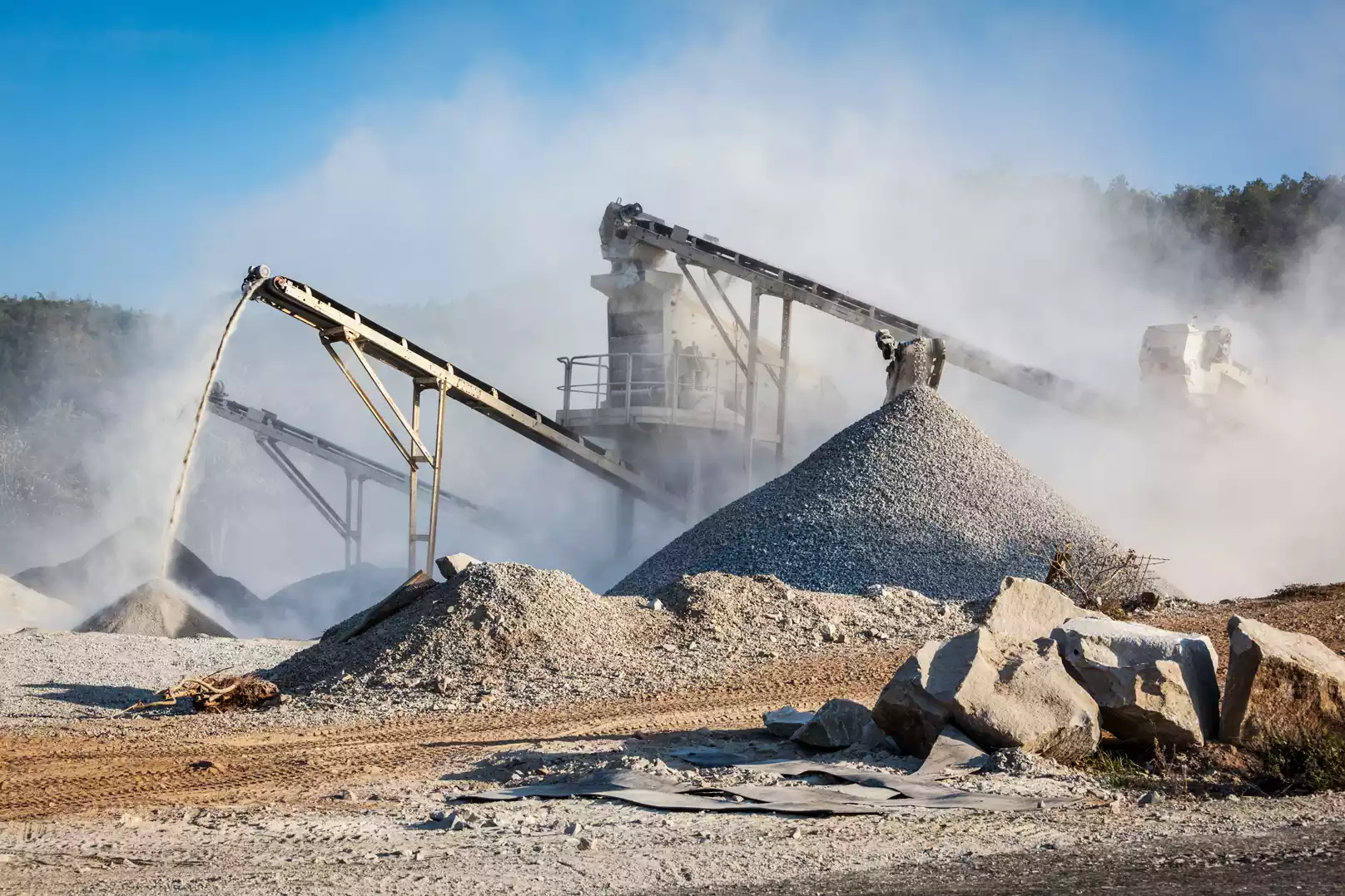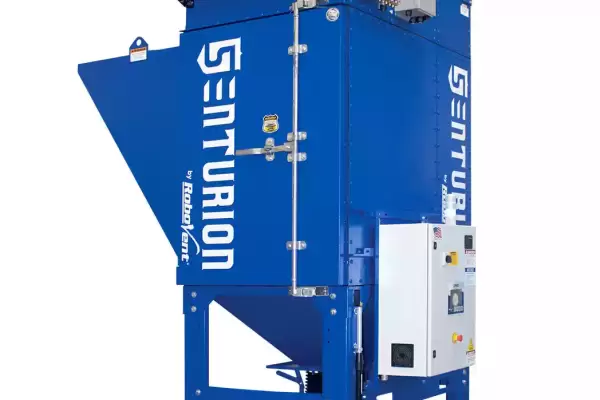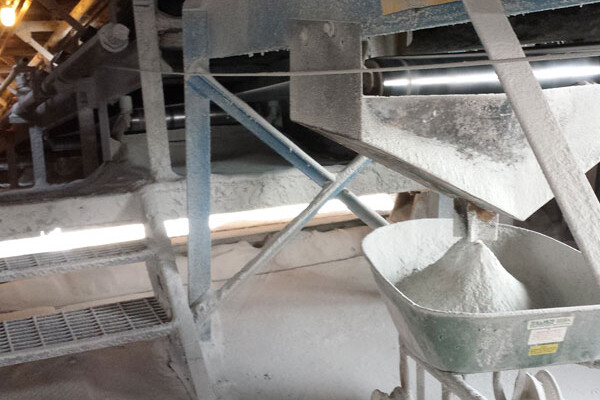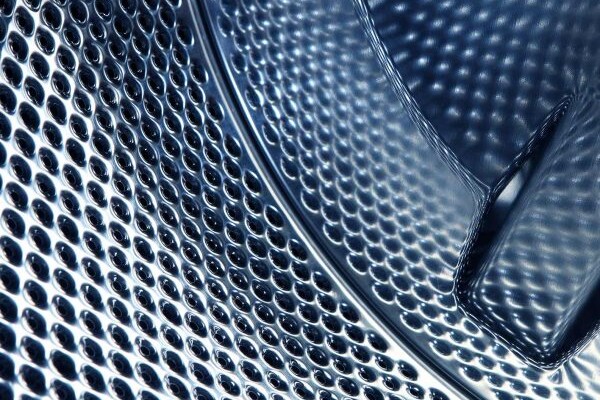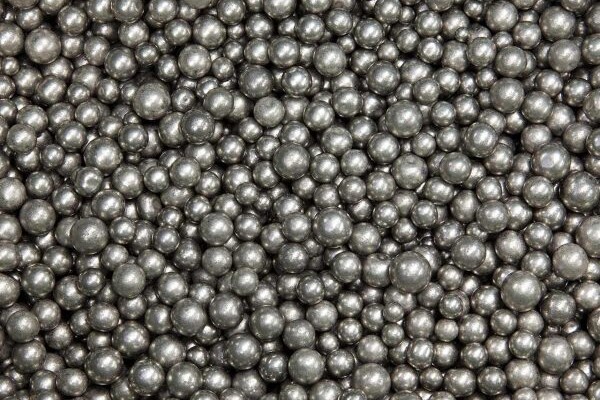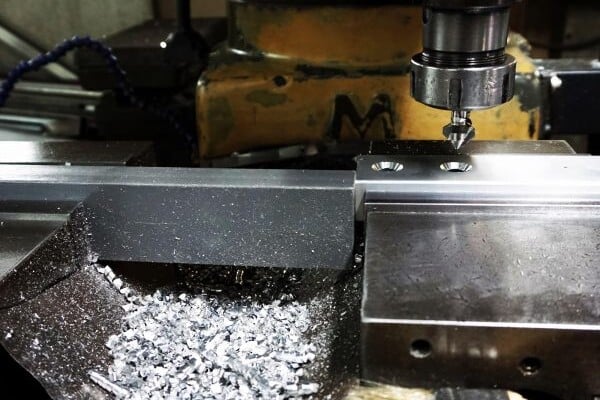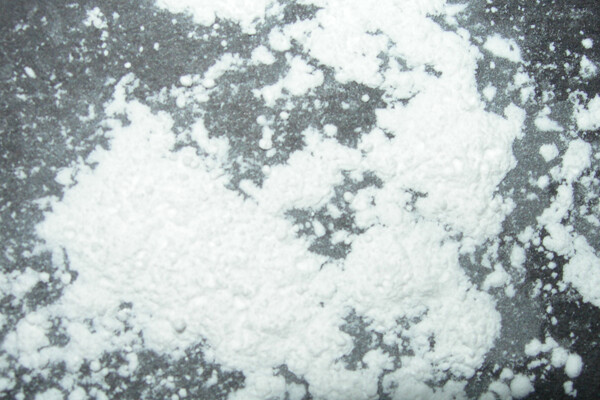SOLUTIONS FOR MINING AND MINERAL PROCESSING
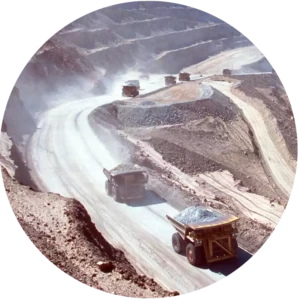 RoboVent offers robust dust control solutions for the mining and mineral processing industry. A RoboVent solutions engineer can design an effective dust control system for your mining and mineral processing application that fully meets ACGIH and NIOSH recommendations. We can help you:
RoboVent offers robust dust control solutions for the mining and mineral processing industry. A RoboVent solutions engineer can design an effective dust control system for your mining and mineral processing application that fully meets ACGIH and NIOSH recommendations. We can help you:
- Evaluate the hazard level and combustion risk of your mining dust
- Design and install a dust control solution tailored to your application
- Maintain your dust collection system for maximum longevity and efficiency
- Ensure compliance with regulations including EPA air quality standards for PM10 and PM2.5 and OSHA, MSHA and NFPA requirements.
RoboVent Senturion is a heavy-duty, versatile dust collector suitable for mining and mineral processing applications. Senturion features:
- A modular design that can be scaled up for heavy-duty dust control and outfitted with abrasion-resistant options for mining applications.
- An advanced filtration system for the smallest footprint per CFM in the industry.
- Heavy-duty cabinet construction, powder-coated inside and out, with optional UHMW lining.
Related Resources
DUST CONTROL CHALLENGES FOR MINING AND MINERAL PROCESSING
Dust control for mining and mineral processing has a number of challenges due to the volume, abrasiveness and toxicity of mining dust. While the specific challenges vary by mineral or ore type and process, there are some general challenges common to all mining applications.
- The volume of dust produced during excavation, transport and processing of minerals and mineral ores is very heavy and can quickly overwhelm standard filtration systems. Dust collection systems for mining and mineral processing may collect thousands of pounds of dust per hour.
- Dust produced by mineral excavation, crushing, grinding and processing is heavy and abrasive. Abrasive mining dust creates a lot of wear and tear on dust collection equipment, ductwork and filters.
- Mining dust may contain toxic or hazardous elements such as silica or heavy metals. Companies need to know what elements are in their dust and take precautions to keep worker exposures within OSHA limits.
- Some types of mining dust, such as coal dust, are highly combustible. Combustion risks are created when combustible dust builds up within a silo, conveyor system or enclosure.
- Mining is a heavily regulated industry. In addition to OSHA regulations, companies engaged in mineral extraction and processing are subject to regulations and inspection from the EPA and the Mine Safety and Health Administration (MSHA).
HEALTH RISKS OF MINING AND MINERAL PROCESSING DUST
Mining and mineral or ore processing produce heavy, abrasive dust that is irritating to the eyes, skin and tissues of the nose, throat and lungs. Dust produced by mining operations may be heavy enough to create visibility challenges or slip-and-fall hazards. Mining dust may also contain elements that are toxic when inhaled.
Lung cancer, pneumoconiosis, asthma, chronic obstructive pulmonary disease (COPD), silicosis and progressive massive fibrosis (PMF) are all associated with exposure to mineral dusts from mining and ore processing. Exposure to heavy metals and other toxic elements in mining dust can lead to a variety of pulmonary, nervous system and developmental and reproductive effects.
The toxicity of mining dust will depend on its exact composition. However, companies in the mining industry should be aware that exposures are not limited to the target mineral or metal; ores and extracted minerals are typically commingled with rock, soil and other non-target elements. A dust analysis can determine the exact composition of dust created at a specific extraction site. These are some of the most common hazards with mining and mineral processing dust.
- Silica: Silica is one of the most common substances on Earth, making up 59% of the Earth’s crust by weight. It is the main constituent of more than 95% of known rocks. Because of its sheer abundance, it is a hazard for virtually all mining applications. Crystalline silica, or quartz (also called silica dioxide, or SiO2), is the main component of sand, granite, sandstone, limestone and other commonly quarried rocks. But because it is present in most rocks and soils, exposure is also a risk when extracting and processing metals and metal ores. Crystalline silica is also the form associated with the most serious health risks. Silicosis is a serious disease caused by inhalation of crystalline silica, which damages the lining of the lungs. Silica exposure is also associated with lung cancer, chronic bronchitis and other respiratory diseases, kidney damage and other systemic health effects.
- Coal dust: Coal mining has long been associated with the infamous “black lung” disease, or coal workers’ pneumoconiosis (CWP). Coal dust scars the lungs over time, impairing the ability to breathe. An estimated 16% of coal miners may be affected by CWP. Coal dust exposure can also result in COPD, chronic bronchitis, emphysema and silicosis (due to the presence of crystalline silica along with carbon in coal dust).
- Asbestos: While asbestos is no longer specifically mined in the U.S. or Canada, coal mines and other mineral mines may be contaminated with it. Asbestos is a type of naturally occurring fibrous silicate mineral. Microscopic fibers become trapped and embedded in lung tissue, where they cause permanent scarring. Asbestos exposure can lead to adverse health effects years or even decades after exposure, including asbestosis, lung cancer and mesothelioma, a deadly cancer of the linings of the abdomen and chest.
- Lead: Lead is one of the most dangerous metals encountered in mineral mining, either through extraction and processing of lead ores (e.g., galena) or through lead contamination in soils, rocks and other mineral ores. Even low-level exposure to lead dust can lead to permanent health effects, especially if exposure is maintained over time. Acute lead dust exposure may cause irritability, headache, vomiting, fatigue or sluggishness, abdominal pain and seizures. Chronic exposure may lead to high blood pressure, joint and muscle pain, concentration and memory issues, mood disorders and reproductive problems. Children are especially susceptible to significant developmental problems with lead exposure; miners may be at risk of carrying lead dust home to their families on clothes, shoes and safety equipment.
- Other metals: Depending on the mine type and location, miners may be exposed to a variety of other metal dusts. Exposure to metal dusts may occur when mining metal ores or when metals are commingled with rock, sand or coal. Most metal dusts are toxic when inhaled. In addition to lead, metal dusts with significant health effects include copper, nickel, cadmium, lithium, manganese, molybdenum, beryllium, chromium, cobalt and zinc. Health risks vary depending on the substance, but many metal dusts are associated with neurological effects and cancer.
- Other toxic exposures: Mining dust may also contain traces of other toxic substances, such as sulfur or arsenic. These exposures and their associated health risks are generally specific to the type and location of the mine.
REGULATIONS FOR MINING AND MINERAL PROCESSING
The mining industry is highly regulated. In the U.S., companies involved in mineral extraction and processing must follow regulations related to dust control from multiple industries, including the Occupational Safety and Health Administration (OSHA), the Environmental Protection Agency (EPA) and the Mine Safety and Health Administration (MSHA)
- OSHA regulates all aspects of worker health and safety, including exposure to hazardous dust and fumes. Companies in the mining industry must meet health and safety standards under OSHA’s General Duty Clause as well as specific standards for permissible exposure levels (PELs) for different types of dust and fumes. Mining falls under the General Industry category for OSHA.
- EPA regulates environmental emissions for the mining industry, which includes quarrying, open-pit mining, surface mining and underground mining for metal and nonmetallic mineral mining, along with processing activities such as crushing, screening and washing. Mines must follow EPA Clean Air regulations for PM10 and PM 2.5 dust.
- MSHA provides additional regulation, oversight and enforcement of worker health and safety and environmental protections for the mining industry.
Permissible Exposure Limits for Mining and Mineral Processing Dust
OSHA has issued specific regulations for many different metallic and nonmetallic dusts found in mining applications. These are expressed as Permissible Exposure Limits (PELs), which are measured and averaged over a worker’s 8-hour shift.
Companies involved with mineral extraction and processing must first consider the general limit for exposure to particulate of any kind (i.e., nuisance dust, PM10 dust). The limit for “Particulates Not Otherwise Regulated” (PNOLs) is 15 mg/m3 (8-hour TWA limit) for total particulate and 5 mg/m3 for respirable particulate. Employers must also follow general housekeeping standards (OSHA 1910.22, Walking-Working Surfaces) to prevent accumulation of dust on surfaces.
Manufacturers are responsible for ensuring that workers are not exposed to hazardous dusts in levels above the PELs. Failure to control dust in areas where workers may be exposed can result in serious fines and legal action. For some highly toxic substances, such as lead and crystalline silica, OSHA also sets a separate action limit; exposures above this limit may require specific compliance activities such as blood testing. These are PELs for some of the metals and other elements found in surface mining, quarrying and mineral ore processing.
- Respirable Crystalline Silica: 50 μg/m3 (PEL)/action limit 25 μg/m3
- Asbestos 0.1 fiber per cubic centimeter (pcc) of air; excursion limit (30 minute) 1.0 fiber pcc
- Lead: 50 μg/m3 (PEL)/action limit 30 μg/m3
- Iron oxide: 10 mg/m3
- Nickel: 1.0 mg/m3
- Tin: 2.0 mg/m3
- Cadmium: 0.005 mg/m3
- Manganese: 5.0 mg/m3
- Cobalt: 0.1 mg/m3
- Lithium hydride: 0.025 mg/m3
- Talc (not containing asbestos fibers): 20 million particles per cubic foot
In general, companies are expected to use engineering controls to reduce exposure levels to within the PELs wherever possible. Personal protection equipment (PPE) should only be relied on in situations where it is not technically possible to meet the PEL through engineering controls.
Environmental Regulations
Companies in the mining industry must meet certain environmental standards, which may include:
- Limits on inhalable particulate emissions (PM 10, PM 2.5) set by the EPA as part of the Clean Air Act.
- National Emissions Standards for Hazardous Air Pollutants (NESHAP)
- Reporting requirements for the Greenhouse Gas Reporting Program (GHGRP)
- State and local air quality regulations
While particles of sand and large dust are not currently regulated, the EPA regulates inhalable (PM 10/10 μm and smaller) and fine respirable (PM 2.5/2.5 μm and smaller) particulate. The EPA sets clean air standards for inhalable and fine respirable particulate that state and local governments are required to enforce. Large particulate producers, including mining companies and mineral processors, are subject to state and local limits on particulate emissions to keep local air quality within EPA regulations.
In general, companies involved in mineral extraction and processing cannot simply allow dust and emissions to go into the atmosphere. That means that companies must have a dust control system in place to collect excess dust for proper disposal.
Combustible Dust Regulations
Some dust types produced by the mining industry are combustible, most notably coal dust. Combustible dusts are regulated under OSHA’s General Duty Clause (Section 5(a)(1)) with additional requirements under the Hazardous Locations (§1910.307), Hazard Communication (§1910.1200) and Housekeeping (§1910.22) standards. OSHA’s Combustible Dust National Emphasis Program (NEP) outlines policies and procedures for inspecting workplaces that create or handle combustible dusts.
In addition, manufacturers dealing with combustible dusts must follow National Fire Protection Association (NFPA) standards for prevention of fires and explosions. Mining dust from metal and nonmetal mining and mineral processing falls under NFPA 122, Standard for Fire Prevention and Control in Metal/Nonmetal Mining and Metal Mineral Processing Facilities. Material handlers in the mining industry may also need to follow NFPA 654, Standard for the Prevention of Fire and Dust Explosions from the Manufacturing, Processing and Handling of Combustible Particulate Solids.
Sand, silica, limestone and gravel dust are generally inert and do not require special combustion precautions. However, these dusts should be tested to determine whether there are other combustible dusts commingled with the rock dust.
CONSIDERATIONS IN DUST CONTROL FOR MINING AND MINERAL PROCESSING
Because of the diversity of dust types and processes represented across the mining and mineral processing industry, there is no “one size fits all” solution for dust control in mining. The National Institute of Occupational Health and Safety (NIOSH) has created the Dust Control Handbook for Industrial Minerals and Mining as an overview of basic principles. Companies should also follow ACGIH general guidelines for industrial ventilation and filtration when designing a dust control solution.
The specifics of the mining dust collection solution will depend on the process, the type and volume of dust produced, and the environment in which the dust is produced. Modifications are likely to be needed to accommodate environmental conditions, the volume and abrasiveness of the dust, and combustion risks.
Environmental Considerations
Because the dust collection system will be outdoors for many mining applications, the dust collector cabinet and ductwork must be built to withstand the elements. Look for:
- Heavy-duty cabinet construction with powder coating inside and out.
- Ductwork materials and tubing designed for heavy-duty use in outdoor environments. Instead of poly tubing, the dust collector may need copper or stainless steel tubing that will withstand heat, moisture and UV exposure.
Abrasive Dust Control
The abrasive nature of mining and mineral processing dusts, along with high overall volumes of dust, creates special challenges for the design of the dust collection system. Dust collectors for mining dust are likely to require modifications to protect the filters and extend the life of the dust collector. These modifications may include:
- Abrasion-resistant air intakes.
- Drop-out boxes to allow coarse, heavy dust to fall out of the airstream before it hits the filters.
- Baffles within the ductwork, intake and filter cabinet to protect the filters.
- Modified hopper design with a steeper slope to help heavy dust fall into the collection bin.
- A heavy-duty, abrasion-resistant lining (such as Ultra-High Molecular Weight (UHMW) plastic) for ductwork and the dust collector cabinet.
Combustible Dust Control
Depending on the volume and combustibility of the dust, the dust collector may need to be equipped with a deflagration system. This system may include:
- explosion vents for safe venting of the energy from a dust collector explosion
- isolation valves to prevent a pressure wave from propagating back into the facility
- rotary airlock to prevent dust in the collection bin from being used to fuel an explosion
Bin Venting
Storage of combustible mining dust will require a bin venting dust collector. The dust collector is mounted directly to the top of the bin, hopper or silo to collect airborne particulate within the enclosure. If the dust is combustible, both the bin vent dust collector and the storage unit should have explosion relief panels.
Filter Considerations for Mining and Mineral Processing Dust
Mining and mineral processing require high-quality, heavy-duty filter media.
- PTFE-coated filters provide better wear and superior dust shedding. Coated filters will last longer than uncoated filters for heavy, abrasive applications.
- If moisture is an issue, make sure the filter media is appropriate for collection of heavy, wet dust.
- Cartridge-style industrial dust collectors should have filters oriented vertically to allow dust to fall off the filter media and into the collection bin.
- A highly efficient filter pulsing system is essential for collection of mining and mineral processing dust. The pulsing system uses a blast of air to help the filters shed excess dust. The system should be designed so that dust is efficiently pulsed off of the entire length of the filters.
Maintenance Reduction
Industrial dust collectors used in mining and mineral production should have features to help reduce maintenance and enable dust collection and disposal without shutting down the unit.
- The dust collection system should allow segmentation so that one part of the unit can be shut down and maintained while other parts are still operating.
The dust collection system will require customization for the volume of dust collected during mining. A conveyor system may be used to collect large volumes of dust and convey it to large storage containers for proper disposal.
Senturion
Senturion Modular Dust Collector ONE TOUGH DUST COLLECTOR. COUNTLESS APPLICATIONS. Senturion i...
Silica Dust Collection Systems
Exposure Risks for Silica Dust Silica dust is inhaled into the lungs, where it is implicated in ...
Iron and Chrome Dust Collection
EXPOSURE RISKS FOR IRON AND CHROME DUST Many industrial processes involve iron or chrome in eith...
Nickel Dust Collection System
EXPOSURE RISKS FOR NICKEL DUST Nickel produces a string of harmful health effects, even at low e...
Aluminum Dust Collection System
EXPOSURE RISKS FOR ALUMINUM DUST While the most common physical problem associated with aluminum...
Talc Dust Collection
EXPOSURE RISKS FOR TALC Since talc is used in such large quantities in industry, concerns mostly...
CONTACT US
Contact one of our industrial dust experts to gain the advantage against dust-generating processes and applications.


